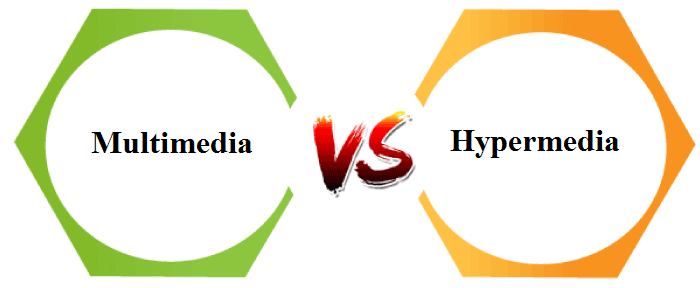Difference between Multimedia and HypermediaYou've probably seen the terms multimedia and hypermedia, which are mainly utilized in the context of computer systems, electronic gadgets, and the internet. The fundamental distinction between these multimedia and hypermedia is that multimedia refers to numerous methods of representing electronic documents or data, including images, graphics, audio, video, etc., over electronic devices via any network medium. In contrast, hypermedia is a set of multimedia that is connected via the internet in a non-linear manner. In this article, you will learn about the difference between Multimedia and Hypermedia. But before discussing the differences, you must know about Multimedia and Hypermedia with their features. What is Multimedia?Multimedia is a type of communication that utilizes a combination of multiple content formats like text, audio, pictures, graphics, animations, or video into a single interactive presentation. Some examples of multimedia are video podcasts, captivating video clips, engaging sounds, audio slideshows and animated videos. Various multimedia software tools and applications are available, such as digital video editing, production system, software building blocks, hardware, electronic newspaper, etc. Features of MultimediaThere are various features of multimedia. Some main features of the multimedia are as follows: 1. Storage and Memory It needs a large amount of storage for higher storage items, including images, graphics, animation, audio, and video. Large caches are also necessary for effective management and are often of Level 2 and 3 hierarchies. 2. Very High Processing Power Multimedia requires high processing power to deal with huge data processing and real-time media delivery. 3. Operating System It requires a high-speed OS that provides a quick response time for interactive apps. It also provides high throughput for batch applications and real-time scheduling. 4. File Formats Multimedia data supports various types of media formats, including AVI, MID, DOC, GIF, WAV, JPEG, MPEG, and PNG. AVI media file format contains both audio and video data in a file. AVI media format supports multiple streaming audios and videos like SVD video format. It also has a restriction on the conversion of one file format to another file format. 5. Network Support It contains LAN, ATM, internet, intranet, WAN, Mobile telephony, etc. In past years, there has been a huge increase in the number of multimedia applications available on the internet, such as streaming video, teleconferencing, virtual worlds, IP telephony, interactive games, and distance learning. These continuous-media applications for multimedia networking have high connection latency requirements. 6. File System The file system should be efficient to fulfil the demands of continuous media. These media files necessitate extremely high disk bandwidth rates. Typically, disks have poor transfer rates and high latency rates, and disk schedulers should reduce latency time to ensure high bandwidth to meet the needs for multimedia data. What is Hypermedia?Hypermedia is an extension version of hypertext that includes numerous types of media, including graphics, video, moving graphics, text, audio, etc. It is a non-linear system that is derived from hypertext and functions similarly to hypertext. It also offers more advanced functionality, such as clickable links on the web page. The most popular type of hypermedia link is an image link, which may lead the user to another page. It is utilized in several apps, from qualitative research and problem-solving to electronic learning and complex learning. WWW is the best example of a hypermedia application as it offers massive content via web servers that can be readily posted and navigated using a web browser. HTTP is the principal protocol for transferring hypermedia. However, other file types are also supported. Key Differences between Multimedia and Hypermedia
There are various key differences between Multimedia and Hypermedia. Some main key differences between Multimedia and Hypermedia are as follows:
Head-to-head comparison between Multimedia and HypermediaHere, you will learn the head-to-head comparisons between Multimedia and Hypermedia. The main differences between Multimedia and Hypermedia are as follows:
ConclusionMultimedia and hypermedia look like similar terms, but these are different. Multimedia is a collection of external renditions of data and information utilizing various coding forms. In contrast, hypermedia is a type of multimedia application in which the multimedia parts are linked using hyperlinks over the internet.
Next TopicDifference between
|
 For Videos Join Our Youtube Channel: Join Now
For Videos Join Our Youtube Channel: Join Now
Feedback
- Send your Feedback to [email protected]
Help Others, Please Share










